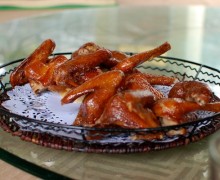Guangzhou, Late Tea Harvest, and the World Tea Expo

The spring is late in coming this year because it has been another very cold winter in China. Even here in the south it has been unseasonably cold. I have been in Guangzhou (Canton) for a few days researching changes to the Chinese export laws to keep up to date so we can forestall any problems concerning our fledgling brokerage service. Guangzhou has always been my departure point for my trips into tea country. It has always been important to me to get in touch with the historical context for a foreign tea merchant.
It is amazing that Guangzhou was the only place where tea was sold in the world during the Qing Dynasty. The Qing Dynasty were Manchurian conquerors who had overthrown the Ming Dynasty; they wanted to keep the treasure of China to themselves, so they set up strict trading rules for the trade in tea.
First of all, tea could not be traded for goods but could only be bought with hard currency. It could only be sold in one place- an island in the Pearl River. Foreigners were not allowed off of this island, nor were Chinese allowed learn or be taught foreign languages. For many years I stayed on this island whenever I visited Guangzhou. It is beautiful and peaceful, studded with old European style houses that were once the great trading houses of Europe.
I have deserted Shamian Island for downtown. I like the energy and activity there as much as I enjoy the peacefulness of the island. I did have some lunch there (famous for its pigeon) which I must say I really love. It is full of brides taking photos for their weddings. Even the American Embassy has moved off the island to larger, grander digs.
Things are very different in China now than in the Qing Dynasty. In some ways, however, things are much the same in the tea business. It is true that the market is open, and anyone can buy tea anywhere, but few tea merchants speak Chinese and tea producers don’t learn English. Foreign tea buyers still buy from the Chinese tea merchants that traffic in misinformation and mediocre tea, and most tea buyers lap up whatever they are told and pass it on to their customers. They feel like they really understand what’s going on, and are arrogant about their insight into Chinese tea. Maybe they’ve gone on a tour of the gardens tightly controlled by their Chinese traders, with lots of marketing photo ops. I have been able to avoid that because I had spent a lot of time in China before starting my business, and my wife is a top notch tea scholar. She has been able to help me navigate through the jungle of misinformation.
In those days Europeans believed that black tea and green tea came from different bushes. This thinking was shockingly ignorant, and we love to laugh at the the merchants of old that believed it. Now most tea instruction starts out that all tea come from the same plant. You may find it somewhere on our site, and we have not been above having repeated this nonsense. Processing determines the difference, for example, between black tea and green tea. Sounds good doesn’t it, but is equally as naive as thinking that what our ancestors thought. Try making a good wulong, from a Bi Lou Chun bush, or a puer from a Taiwan wulong bush. Still it gets repeated as if it a epiphany. I guess both versions could be true an the surface, but neither are true when you look just a little bit deeper. It is true that in the west there is a lot of tea science relayed to what is outside of China, but that is like know the tail of the elephant really well.
Still China remains for the most part a black box, not because the emperor has declared it, but because the chasms created by culture and language are vast. These chasms are so vast that it is even quite impossible to get your mind around the problem, and the more knowledgeable you acquire, the farther away you find yourself from having an understanding. The result? Almost all of the really great tea stays in China, and it even remains hard for most Chinese to buy because it ends up in the tea cups of Chinese elites much as it did in the thousands of years that have come before. But that is China-always changing and always staying the same.
So what does all of this have to do with the World Tea Expo, the World Tea Championships, and the World Tea News? (Perhaps you may have read a lot recently about how the weather has affected the 2011 tea crop in China.) Well, you will just have to continue reading my blogs to find out.
